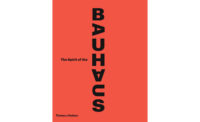Bauhaus: 1919–1933, by Magdalena Droste. Taschen, 400 pages, $50.
Produced in collaboration with the Bauhaus-Archiv/Museum für Gestaltung in Berlin, which has the largest collection Bauhaus documents and works, this revised and updated edition of a 1990 book offers a comprehensive look at the famous school. The author, who worked at the Bauhaus-Archiv and was a professor of art history at the Brandenburg University of Technology, Cottbus, covers the three iterations of the school—in Weimar, Dessau, and Berlin—examining the ideas and personalities that drove each one. More than 500 illustrations show the full range of work produced at the Bauhaus, from weavings and pottery to graphic design and architecture.
Bauhaus Imaginista: A School in the World, edited by Marion von Osten and Grant Watson. Thames & Hudson, 312 pages, $60.
This large-format book (over 9 by 12 inches) looks at the Bauhaus’s impact around the globe. Essays by artists, historians, and cultural theorists— such as Beatriz Colomina, Mark Wigley, Eduard Kögel, Zvi Efrat, and Magdalena Droste—chart the dissemination of Bauhaus ideas to places as diverse as India, Japan, and Nigeria, and also examine some of the cultures the Bauhaus drew upon, from North Africa, Mexico, and Argentina.
Giedion and America: Repositioning the History of Modern Architecture, by Reto Geiser. gta Verlag, 465 pages, $85.
This reevaluation of the work of Sigfried Giedion focuses attention on the Swiss art and architecture historian’s stays in the U.S. and his lectures at Harvard in the late 1930s, when Walter Gropius was chair of the architecture department. The lectures preceded the publication of the landmark Space, Time and Architecture: the Growth of a New Tradition, in 1941. Giedion, who was an active member of the Modernist movement as both a scholar and secretary general of the International Congresses for Modern Architecture (CIAM), developed close relationships with key intellectuals from a range of fields, including media theorist Marshall McLuhan, writer Lewis Mumford, architect Josep Lluís Sert, and artist László Moholy-Nagy. Geiser paints Giedion as a valuable figure “in between”—continents, professions, and intellectual contexts.
The ABC’s of Triangle, Square, Circle: The Bauhaus and Design Theory, edited by Ellen Lupton and J. Abbott Miller. Princeton Architectural Press, 72 pages, $30.
A fascinating work of design theory and graphic design, this new edition of a book first published in 1991 starts with Wassily Kandinsky’s assertion of a universal correspondence between the three elementary shapes and the three primary colors. As the editors explain, “the dynamic triangle is inherently yellow, the static square is intrinsically red, and the serene circle is naturally blue.” Lupton, who is a graphic designer and a curator at the Cooper Hewitt, and Miller, who is a graphic designer and partner at Pentagram, explore the Bauhaus notion “that two-dimensional design is a language structured by universal laws of geometry and perception.”
Mid-Century Modern Architecture Travel Guide: East Coast USA, by Sam Lubell, with photography by Darren Bradley. Phaidon, 377 pages, $35.
The author, a former RECORD editor, calls this book a Midcentury Modern road trip from New Hampshire to Florida. The handsome design, new color photography, and informative text make it a pleasant journey that includes a number of works by Bauhaus alums such as Gropius, Breuer, and Mies. The book offers a helpful introduction and then presents more than 250 buildings, ranging from the Gropius House in Lincoln, Massachusetts, to Breuer’s Stillman House I in Litchfield, Connecticut, and Mies’s One Charles Center in Baltimore. The author lets you know if each destination is open to the public, charges an admission fee, or has a café/restaurant or gift/bookshop. If you’re a Modernist junkie and are planning trips to Manchester, New Hampshire; Norfolk, Virginia; or Sarasota, Florida, you’ll want to bring this guide along for the ride.
Bauhaus Goes West: Modern Art and Design in Britain and America, by Alan Powers. Thames and Hudson, 256 pages, $40.
Powers, who teaches architecture and cultural history in London, traces the impact of the Bauhaus diaspora after the Nazis closed the school in 1933 and key figures such as Gropius, Breuer, and Moholy-Nagy made their way to Britain and then America. The author examines the exchange of ideas between continental Modernism and progressive design in both the UK and the U.S.










